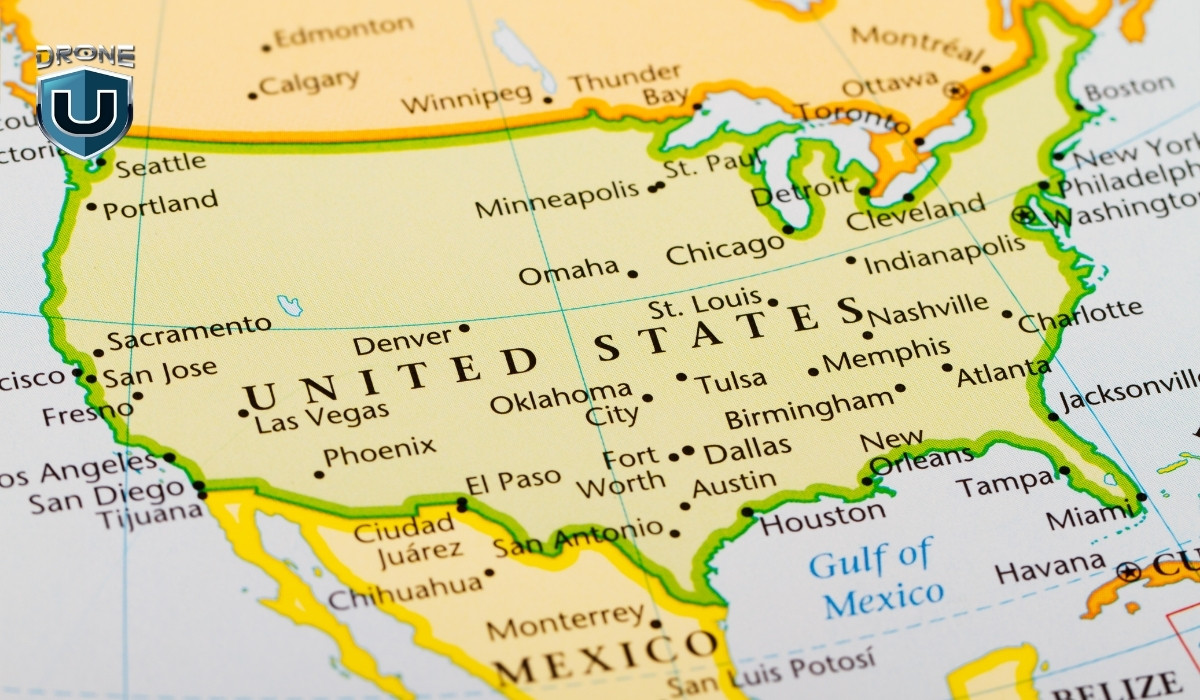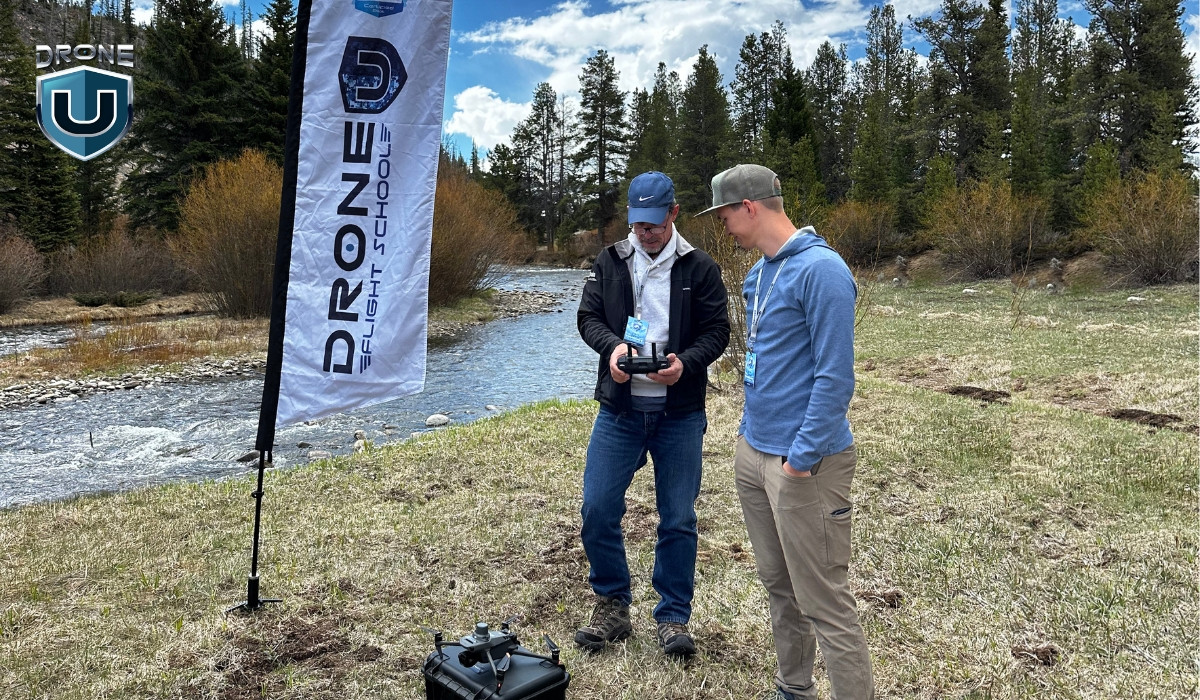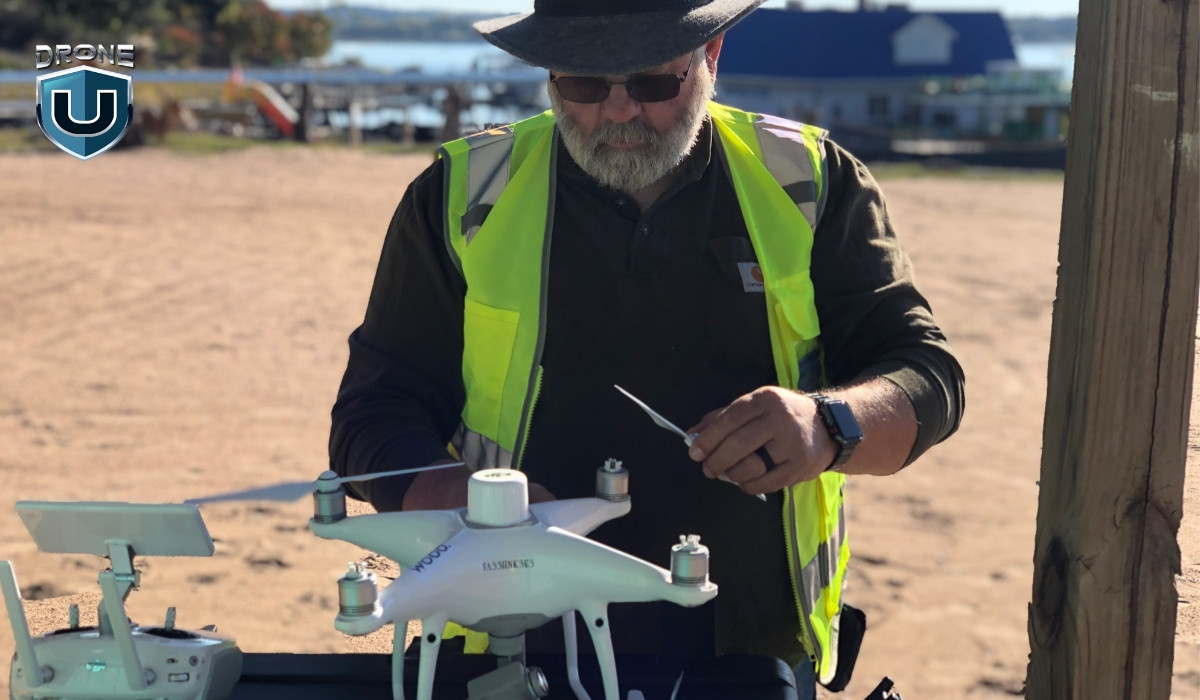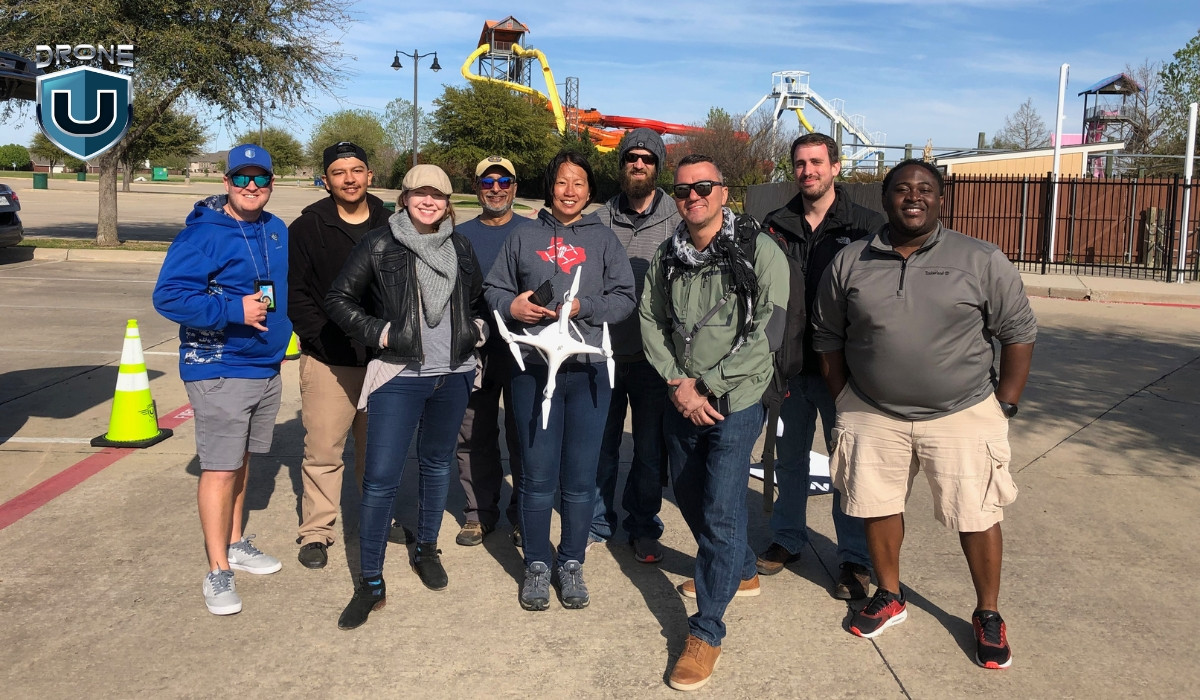Flying drones in the US is legal but requires understanding and following regulations set by the Federal Aviation Administration (FAA). At flyermedia.net, we provide up-to-date information on these aviation regulations to help drone enthusiasts and professionals alike navigate the skies safely and legally. Learn more about unmanned aircraft systems (UAS) rules and ensure a seamless flying experience.
1. Quick Overview of FAA Drone Laws
The FAA has established several regulations for drone operations in the United States. Understanding these rules is crucial for every drone pilot, whether you’re flying for fun or for commercial purposes. Let’s break down the key aspects of these regulations.
- FAA Regulation: Drones are primarily regulated by the FAA.
- Safety Guidelines: All drone pilots must adhere to FAA safety guidelines.
- Registration: Drones weighing over 0.55 lbs (250g) must be registered.
- Visual Line of Sight (VLOS): Operators must maintain visual line of sight with their drone at all times.
- Remote ID: Most drone flights now require Remote ID compliance.
- Pilot Categories: Recreational, commercial, and foreign pilots have different rules.
- Substance Use: Flying under the influence of drugs or alcohol is strictly prohibited.
- Operational Restrictions: Avoid flying over people, moving vehicles, or large crowds.
2. FAA New Rules and Drone Laws in the USA
Flying drones in the United States is legal, provided you follow the regulations set by the FAA. These regulations are designed to ensure safety and prevent misuse of drones in the national airspace. The FAA continually updates these rules to address new challenges and advancements in drone technology.
 FAA New Rules and Drone Laws in the USA
FAA New Rules and Drone Laws in the USA
2.1 Understanding FAA Regulations
The FAA manages the airspace in the United States and has established regulations that drone pilots must understand and follow. These regulations cover various aspects of drone operation, including registration, operational restrictions, and pilot certifications.
2.2 Key Sections of Drone Laws
To simplify the information, drone laws are divided into four main sections:
- General Drone Rules: Basic regulations applicable to all drone pilots.
- Rules for Recreational Pilots: Specific regulations for hobbyists.
- Rules for Commercial Pilots: Rules for those using drones for business purposes.
- Rules for Foreign Pilots: Regulations for non-U.S. citizens flying drones in the U.S.
3. General Drone Flying Laws & Federal Regulations
No matter the purpose of your flight, certain fundamental regulations apply to all drone pilots in the U.S. These rules ensure the safety of the national airspace and the protection of people and property on the ground.
 General UAS Flying Regulations
General UAS Flying Regulations
3.1 Essential Regulations for All Drone Pilots
- Altitude Limit: Fly at or below 400 feet.
- Registration: All drones weighing between 0.55 lbs (250 g) and 55 lbs (25 kg) must be registered with the FAA.
- Marking: Your drone must be marked with your FAA registration number.
- B4UFLY App: Use the FAA’s B4UFLY Mobile App for real-time airspace information and restrictions.
- No-Fly Zones: Be aware of and avoid no-fly zones, especially around airports and restricted areas.
- Visual Line of Sight: Maintain visual line of sight with the drone at all times.
- Airspace Restrictions: Understand and comply with airspace restrictions, especially around airports.
- Remote ID: Comply with Remote ID requirements unless flying in an FAA-Recognized Identification Area (FRIA).
- Right of Way: Always give way to other aircraft.
- LAANC: Use the Low Altitude Authorization and Notification Capability (LAANC) system for controlled airspace authorization.
3.2 Compliance and Responsibility
Anyone operating a drone in the U.S. National Airspace System (NAS) is responsible for adhering to FAA guidelines and regulations. Non-compliance can result in fines and other penalties.
4. Drone Regulations for Recreational Pilots
If you are flying a drone for recreational purposes, you must follow specific rules designed to ensure safety and compliance with FAA regulations.
 Drone Regulations for Recreational Pilots
Drone Regulations for Recreational Pilots
4.1 Rules for Flying Drones for Fun
- TRUST Exam: Pass the Recreational UAS Safety Test (TRUST).
- Proof of Completion: Carry proof of TRUST completion while flying.
- CBO Guidelines: Follow the safety guidelines of an FAA-recognized Community Based Organization (CBO).
- Altitude in Class G Airspace: Fly at or below 400 feet in Class G (uncontrolled) airspace.
- Airspace Authorization: Obtain authorization through LAANC or DroneZone before flying in controlled airspace (Class B, C, D, and E airspace).
- FAA Registration: Maintain a current FAA registration, mark your drones with the registration number, and carry proof of registration.
- Safe Operation: Avoid operating your drone in a way that risks the safety of the national airspace.
4.2 Additional Information
If you are unsure which category you fall into, it is recommended to fly under Part 107 (commercial rules). There are also exceptions for Limited Recreational UAV Operations, detailed in Advisory Circular 91-57C.
5. Drone Regulations For Commercial Drone Pilots
Commercial drone operations, such as mapping, filming, and public safety activities, are subject to specific regulations. To legally operate a drone for commercial purposes, you must comply with the following drone laws.
 Drone Regulations For Commercial Drone Pilots
Drone Regulations For Commercial Drone Pilots
5.1 Requirements for Commercial Drone Pilots
- Remote Pilot Certificate: Obtain a Remote Pilot Certificate (Part 107 license) from the FAA.
- Knowledge Exam: Pass the initial aeronautical knowledge exam: “Unmanned Aircraft General – Small (UAG)”.
- Age Requirement: Be at least 16 years old.
- Language Proficiency: Be able to understand, read, write, and speak English.
- Mental and Physical Ability: Be mentally and physically able to operate a UAV safely.
- IACRA Profile: Create an IACRA (Integrated Airman Certification and Rating Application) profile and obtain an FAA Tracking Number (FTN) before taking the knowledge test.
- Night Operations and Operations Over People: You can fly drones at night, over people, and moving vehicles without a waiver under Part 107, provided the rules are followed. Airspace authorization is still required for night operations in controlled airspace under 400 feet.
5.2 Resources for Obtaining a Remote Pilot Certificate
For more information on obtaining a Remote Pilot Certificate, visit flyermedia.net for detailed guides and resources.
6. FAA Drone Laws for Foreigners Visiting the USA
Foreign visitors who plan to fly drones in the United States must comply with the relevant drone laws. The requirements differ based on whether the drone is being used for recreational or commercial purposes.
 Regulations for Foreigners Visiting the USA
Regulations for Foreigners Visiting the USA
6.1 Regulations for Recreational Use
- Follow all rules for Recreational Flyers (TRUST exam).
- Register through the FAA’s DroneZone portal.
- Complete the process under “The Exception for Recreational Flyers.”
6.2 Regulations for Commercial Use
- Comply with all applicable rules and requirements for Commercial Flyers (Part 107 exam).
- Obtain a foreign aircraft permit issued by the Department of Transportation before any U.S. commercial operations.
- Follow the permit application process under Part 375.
6.3 Important Considerations
The FAA considers the issued certificate as recognition of ownership rather than a U.S. aircraft registration certificate for foreign operators. It is also advisable to consider travel insurance that includes liability coverage for drone flights.
7. FAA New Remote ID Drone Rules [2025 Update]
As of September 16, 2023, most drone pilots are required to comply with Remote ID regulations. Remote ID serves as a “digital license plate” for drones, broadcasting identification and location information during flight.
7.1 Understanding Remote ID
As of 2025, all drones that require registration must broadcast a Remote ID signal. This requirement aims to enhance safety and accountability in drone operations.
7.2 Compliance Methods
- Standard Remote ID Drone: Use drones with built-in Remote ID capability.
- Remote ID Broadcast Module: Add a Remote ID broadcast module to existing drones.
- FAA-Recognized Identification Area (FRIA): Operate in an FAA-Recognized Identification Area (FRIA) for non-RID drones only.
7.3 Additional Resources
For more detailed information, check out articles on Remote ID available on flyermedia.net.
8. How to Register My Drone With the FAA
If your drone weighs more than 250 grams (0.55 pounds), you are required to register it with the FAA. However, if your drone is under 250 grams and used solely for recreational purposes, registration is not required.
8.1 Determining Pilot Type
Use the FAA’s User Identification Tool or visit the Getting Started page for more information to determine your pilot type. This will help you understand the specific registration requirements that apply to you.
8.2 Information Required for Drone Registration
- Make and model of your drone
- Email address
- Physical address and mailing address (if different)
- Phone number
- Payment method (credit or debit card)
- Specific Remote ID serial number (if applicable)
8.3 FAA Drone Registration Requirements
- You must be at least 13 years old. If you are under 13, an older individual must register the drone for you.
- You must be a U.S. citizen or legal permanent resident of the United States.
8.4 Drone Registration Fees and Validity
- Cost: $5 per drone registration
- Validity: Registration is valid for three years
8.5 Important Note
Once you register your drone, you cannot transfer it between different user types (Part 107 or the Exception for Recreational Flyers). Ensure you select the correct registration type based on your intended use.
9. Understanding Airspace Restrictions
Navigating airspace restrictions is crucial for safe and legal drone operations. The FAA categorizes airspace to manage air traffic and ensure safety, and understanding these classifications is essential for every drone pilot.
9.1 Types of Airspace
- Class A Airspace: Extends from 18,000 feet mean sea level (MSL) to 60,000 feet MSL. Requires specific pilot certification and aircraft equipment, generally not relevant for most drone operations.
- Class B Airspace: Surrounds the nation’s busiest airports. Requires permission from air traffic control (ATC) for drone operations. Use LAANC for authorization.
- Class C Airspace: Surrounds airports with a control tower, radar approach control, and a certain number of instrument flight rules (IFR) operations. Requires permission from ATC; LAANC can be used for authorization.
- Class D Airspace: Surrounds airports with a control tower but without radar approach control. Requires permission from ATC; LAANC can be used for authorization.
- Class E Airspace: Controlled airspace that is not Class A, B, C, or D. Extends upward from either the surface or a designated altitude to the overlying airspace. Typically requires no ATC permission for drone operations below 400 feet, but Remote ID requirements still apply.
- Class G Airspace: Uncontrolled airspace where no ATC permission is required for drone operations. However, pilots must still adhere to all general drone regulations.
9.2 Tools for Identifying Airspace Restrictions
- B4UFLY App: Provides real-time information about airspace restrictions based on your GPS location.
- sectional Charts: Aeronautical charts that provide detailed information about airspace, navigation aids, and other important features. Available online and in print.
- LAANC: The Low Altitude Authorization and Notification Capability allows drone pilots to request and receive automated airspace authorization for controlled airspace near airports.
9.3 Operating Near Airports
Flying near airports requires extra caution due to the increased risk of collision with manned aircraft. Always check airspace restrictions and obtain necessary authorizations before flying in these areas.
9.4 FAA Resources
Refer to the FAA website and flyermedia.net for comprehensive guides and resources on understanding and navigating airspace restrictions.
10. Understanding Waivers and Authorizations
In certain situations, drone pilots may need to obtain waivers or authorizations from the FAA to operate outside the standard regulations. These waivers and authorizations allow for operations that would otherwise be prohibited, provided they can be conducted safely.
10.1 Common Waivers
- Night Operations: Allows commercial drone pilots to fly at night without needing to apply for a Certificate of Waiver, provided they meet certain requirements, such as proper lighting on the drone.
- Operations Over People: Allows drone pilots to operate over people, provided the drone meets specific design and operational requirements to minimize risk.
- Beyond Visual Line of Sight (BVLOS): Allows drone pilots to fly beyond visual line of sight, which requires demonstrating that the operation can be conducted safely without posing a risk to other aircraft or people on the ground.
10.2 How to Apply for a Waiver
- Eligibility: Determine if your proposed operation requires a waiver by reviewing the FAA’s regulations and guidance.
- Application: Submit a detailed application to the FAA through the FAA DroneZone portal, including a description of the proposed operation, the reasons for the waiver, and the safety measures that will be implemented.
- Safety Justification: Provide a thorough safety justification, demonstrating how the operation can be conducted safely and without endangering people or property.
- Review: The FAA will review the application and may request additional information or clarification.
- Approval: If the FAA approves the application, they will issue a waiver with specific terms and conditions that must be followed during the operation.
10.3 Airspace Authorizations
Airspace authorizations are required for drone operations in controlled airspace near airports. The LAANC system provides automated airspace authorization for eligible pilots.
10.4 FAA Resources
Refer to the FAA website and flyermedia.net for detailed information on waivers, authorizations, and the application process.
11. The Importance of Continuous Learning
The field of drone technology and regulation is constantly evolving, making continuous learning essential for all drone pilots. Staying informed about the latest FAA rules, best practices, and technological advancements will help you operate safely and legally.
11.1 FAA Resources
- FAA Website: The primary source for official regulations, guidance, and updates.
- FAA Safety Briefings: Regular publications that provide insights into safety-related topics and regulatory changes.
- Webinars and Seminars: Educational events that cover various aspects of drone operations and regulations.
11.2 Industry Associations
- Association for Unmanned Vehicle Systems International (AUVSI): A professional organization that provides resources, networking opportunities, and advocacy for the drone industry.
- Drone Manufacturers Alliance (DMA): An alliance of drone manufacturers that promotes safety, innovation, and regulatory compliance.
11.3 Educational Resources on flyermedia.net
- Articles and Guides: Comprehensive articles and guides on various topics, including regulations, safety, and best practices.
- News Updates: The latest news and updates on drone-related developments and regulatory changes.
- Community Forums: Engage with other drone pilots and industry professionals to share knowledge and experiences.
11.4 Staying Compliant
Regularly review and update your knowledge of drone regulations and best practices to ensure you remain compliant with FAA requirements.
12. Drones and Privacy Concerns
As drone technology becomes more advanced and accessible, privacy concerns have risen. Understanding the legal and ethical considerations related to drone operations is crucial for responsible drone use.
12.1 Legal Framework
- Federal Laws: While there are no specific federal laws that directly address drone privacy, existing laws such as the Fourth Amendment (protection against unreasonable searches and seizures) apply.
- State Laws: Many states have enacted laws to protect individuals from drone surveillance. These laws vary but often include restrictions on drone flights near private property, limitations on data collection, and prohibitions on using drones for voyeurism.
- Local Ordinances: Some cities and counties have also implemented ordinances to regulate drone operations, including restrictions on flight paths, data collection, and noise levels.
12.2 Best Practices for Protecting Privacy
- Awareness: Understand the privacy laws and regulations that apply to your drone operations.
- Transparency: Be transparent about your drone operations and inform individuals when you are flying in areas where they may be affected.
- Data Minimization: Collect only the data that is necessary for your intended purpose and avoid collecting sensitive information.
- Security: Implement security measures to protect the data you collect from unauthorized access or disclosure.
- Respect Boundaries: Respect private property boundaries and avoid flying drones near residential areas without permission.
- Avoid Surveillance: Do not use drones for surveillance or monitoring activities without a legitimate purpose and proper authorization.
12.3 Resources for Further Information
Refer to the FAA website, state government websites, and industry associations for more information on drone privacy laws and best practices.
13. Insurance Requirements for Drone Operations
Having adequate insurance coverage is essential for drone operations, whether you are flying for recreational or commercial purposes. Insurance can protect you from financial losses resulting from accidents, property damage, or personal injury.
13.1 Types of Drone Insurance
- Liability Insurance: Covers damages or injuries caused to third parties as a result of your drone operations. This is the most common type of drone insurance.
- Hull Insurance: Covers physical damage to your drone itself, whether caused by an accident, crash, or other incident.
- Payload Insurance: Covers damage to the payload attached to your drone, such as cameras, sensors, or other equipment.
- Ground Equipment Insurance: Covers damage to ground equipment used in your drone operations, such as controllers, batteries, and charging stations.
13.2 Factors Affecting Insurance Costs
- Type of Operation: Commercial drone operations typically require more comprehensive insurance coverage than recreational flights.
- Drone Value: The value of your drone and payload will affect the cost of hull and payload insurance.
- Coverage Limits: Higher coverage limits will result in higher premiums.
- Pilot Experience: Insurers may offer lower rates to experienced pilots with a proven safety record.
- Location: Drone operations in densely populated areas or near airports may require higher premiums.
13.3 Insurance Providers
Several insurance providers specialize in drone insurance, including:
- Skywatch.AI
- Drone Insurance
- Verifly
13.4 FAA Requirements
The FAA does not require drone pilots to carry insurance, but it is highly recommended to protect yourself from potential liabilities.
14. State and Local Drone Laws
In addition to federal regulations, many states and local jurisdictions have enacted their own laws governing drone operations. These laws can vary widely and may impose additional restrictions on drone flights.
14.1 Common State and Local Regulations
- Restrictions on Drone Flights Near Critical Infrastructure: Many states have laws that prohibit or restrict drone flights near critical infrastructure such as power plants, water treatment facilities, and correctional facilities.
- Limitations on Drone Surveillance: Some states have laws that limit the use of drones for surveillance purposes, particularly near private property.
- Prohibitions on Weaponized Drones: Several states have laws that prohibit the use of drones equipped with weapons.
- Restrictions on Drone Flights Over Crowds: Some local jurisdictions have ordinances that restrict drone flights over large crowds or public events.
- Requirements for Drone Operator Permits: A few states require drone operators to obtain a permit or license before conducting commercial drone operations.
14.2 Resources for Researching State and Local Laws
- State Government Websites: Check the websites of state legislatures and departments of transportation for information on state drone laws.
- Local Government Websites: Review the websites of city and county governments for local ordinances related to drone operations.
- Industry Associations: Contact industry associations such as AUVSI for information on state and local drone laws.
14.3 Staying Compliant
Stay informed about the state and local drone laws that apply to your operations and comply with all applicable regulations.
15. Future Trends in Drone Regulation
As drone technology continues to evolve, so too will the regulations governing its use. Staying informed about emerging trends in drone regulation is essential for preparing for the future of drone operations.
15.1 Remote ID Expansion
The FAA’s Remote ID rule is expected to expand in the coming years, with potential requirements for all drones, regardless of size or purpose, to broadcast identification and location information.
15.2 Integration of Drones into the National Airspace System
The FAA is working to integrate drones into the National Airspace System (NAS), allowing for more complex drone operations such as package delivery and urban air mobility.
15.3 Cybersecurity Standards
As drones become more connected and sophisticated, cybersecurity threats will become a greater concern. The FAA and other government agencies are working to develop cybersecurity standards for drone operations.
15.4 Autonomous Drone Operations
Advancements in artificial intelligence and machine learning are paving the way for more autonomous drone operations, which will require new regulatory frameworks to address safety and liability concerns.
15.5 International Harmonization
Efforts are underway to harmonize drone regulations internationally, which will facilitate cross-border drone operations and promote global standards for safety and security.
15.6 FAA Resources
Refer to the FAA website and flyermedia.net for updates on emerging trends in drone regulation.
16. Frequently Asked Questions
16.1 Are drones allowed in the USA?
Yes, drones are permitted in the United States for both recreational and commercial purposes, subject to FAA and local regulations. The Federal Aviation Administration (FAA) approves commercial drone flights under Part 107 and flying recreational drones under the FAA TRUST test.
16.2 Can tourists bring drones to the USA?
Yes, but they must register and follow FAA rules just like residents.
16.3 Do I need a license to fly a drone recreationally?
No, but you must pass the TRUST test and carry proof of completion.
16.4 Can I fly a drone in a national park?
No. Drone use is banned in all U.S. National Parks (state laws vary) unless you have a special permit.
16.5 Can you fly a drone at night?
Yes, you can fly drones at night under Part 107. However, airspace authorizations are required for night operations in controlled airspace under 400 feet. For more information, visit the Part 107 Waiver page.
16.6 Can I fly in a NOAA-protected area?
Check the specific regulations for the NOAA-protected area you plan to fly in. Some areas may have restrictions or prohibitions on drone flights to protect wildlife and sensitive ecosystems.
16.7 What is the FAA TRUST test?
The Recreational UAS Safety Test (TRUST) is a test required for recreational drone pilots to demonstrate basic knowledge of drone safety and regulations.
16.8 What is LAANC?
The Low Altitude Authorization and Notification Capability (LAANC) is a system that allows drone pilots to request and receive automated airspace authorization for controlled airspace near airports.
16.9 What is Remote ID?
Remote ID is a technology that allows drones to be identified remotely, providing information about the drone’s location, altitude, and identification.
16.10 Where can I find more information about drone laws?
Visit the FAA website and flyermedia.net for comprehensive information about drone laws and regulations.
17. Conclusion
Navigating the laws on flying drones in the USA requires diligence and a commitment to staying informed. Whether you’re a hobbyist or a professional, understanding and adhering to FAA regulations is essential for safe and legal drone operations. From registration and Remote ID to airspace restrictions and privacy concerns, there’s a lot to consider. By staying informed and utilizing resources like flyermedia.net, you can confidently explore the skies while ensuring the safety of yourself and others. Remember, continuous learning and adaptation are key as drone technology and regulations continue to evolve. So, keep exploring, keep learning, and keep flying safely.
Ready to take your drone skills to the next level? Visit flyermedia.net today to discover comprehensive resources, news, and opportunities in the aviation world. Whether you’re seeking flight training, exploring career options, or simply passionate about aviation, flyermedia.net is your ultimate guide. Contact us at [Address: 600 S Clyde Morris Blvd, Daytona Beach, FL 32114, United States. Phone: +1 (386) 226-6000.